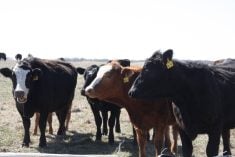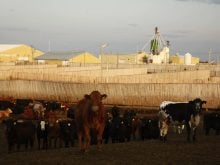This cattle market information is selected from the weekly report from Canfax, a division of the Canadian Cattlemen’s Association. More market information, analysis and statistics are available by becoming a Canfax subscriber by calling 403-275-5110 or at www.canfax.ca.
Fed cattle lower
There was insufficient trade to establish a Canfax weekly weighted average price for steers and heifers last week.
Dressed bids were $227-$232 per hundredweight delivered, which was steady to $5 lower. Live bids were reported in the mid $130s, down $1.50 from the previous week.
Read Also

Crop quality looks good this year across Prairies
Crop quality looks real good this year, with the exception of durum.
Western Canadian cattle feeders have been gaining market leverage over packers, resulting in improved basis and strengthening cash prices. The West is doing better than the Ontario market.
Based on 10 years of prices, there is on average a 14 percent rally from the low point in the second half of the year to the high point. So far, the rally has carried prices up only 7.5 percent.
Based on history, there is potential for the cash price to rise to $140 before the year ends.
Fed supplies are expected to be manageable, and packers are still looking for supply for the second half of November.
In the United States, packer bids for cash cattle in the Plains stood at US$101-$102 per cwt. against animals priced at $106-$108, Reuters reported. Cash cattle moved at $102-$105 the previous week.
Excellent fall feeding conditions in the U.S. are causing cattle to gain weight faster than normal, leading to more cattle on the market than expected.
Cow price falls
D1, D2 cows ranged C$75-$90 to average $81.64 per cwt., down $3.36. D3 cows ranged $70-$81 to average $75.30, up $1.50.
Rail grade cows ranged $156-$161.
Slaughter bulls averaged $100.25, down $1.94.
Auction volume increased as it normally does this time of year.
Slaughter also rose with 9,907 killed to Nov. 5, up 41 percent from the previous week and the largest non-fed kill of the year.
Weekly exports to the U.S. to Oct. 29 rose 31 percent to 6,586.
Numbers at auction this week are expected to increase again, keeping the pressure on prices.
Fall run continues
Auction volume was the biggest this year but still short of expectation.
The week’s auction volume rose five percent to 85,137 head, which was six percent less than last year at the same time.
Good weather means producers are harvesting rather than weaning calves.
Calves lighter than 600 pounds were steady to higher, and those heavier than 600 lb. traded $1-$2 lower.
The heifer calf-to-yearling spread widened a little but is extremely narrow for this time of year.
Weekly exports to Oct. 29 were 3,579.
More calves should be weaned and head to market as the harvest wraps up.
Bred cows ranged $1,160-$2,250, and bred heifers ranged $1,300-$2,100.
Cattle on feed
There were 741,853 cattle on feed in Alberta and Saskatchewan Nov. 1, down 15 percent from the same time last year and the smallest for the month since the report began in 2000.
Placements in October were 229,972, down one percent. Many were yearlings.
Marketings were 133,841, up six percent. The aggressive marketing lowered carcass weights, which fell below year ago levels for the first time in more than two years.
It was the first month since January that the proportion of heifer placements was below a year ago.
Market-ready numbers will continue to tighten into early 2017 because placements have run well below the year ago level since April.
Beef lower
The market will closely monitor beef retail demand as the American market heads toward its Thanksgiving with its usual demand for turkey and ham.
Attractive packer margins are keeping the U.S. slaughter pace strong. Overall, U.S. beef and pork production this fall is running close to eight percent ahead of last year at the same time. The increase is coming from more animals slaughtered rather than higher carcass weights.
U.S. Choice fell US$4.19 per cwt. to $184.55, and Select fell $3.42 to $170.45 Nov. 9.
Canadian cut-out values for the week ending Nov. 4 were unavailable.














